F-1 theme by Nigel Mansell
Download: F-1.p3t
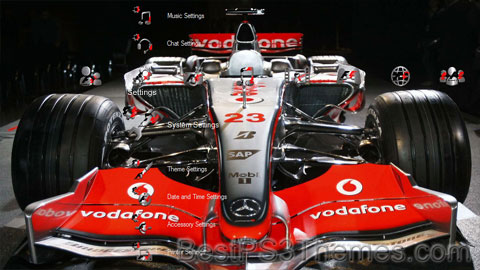
(6 backgrounds)
Redirect to:

The #1 spot for Playstation themes!
Scuderia theme by Paja
Download: Scuderia.p3t
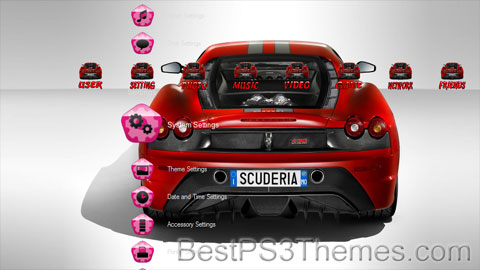
(3 backgrounds)
Scuderia means stable (noun) in the Italian language. It has entered English usage mainly through professional auto racing, in which many Italian teams incorporate the term in their names.
"Scuderia" may refer to:
500 theme by Paja
Download: 500.p3t
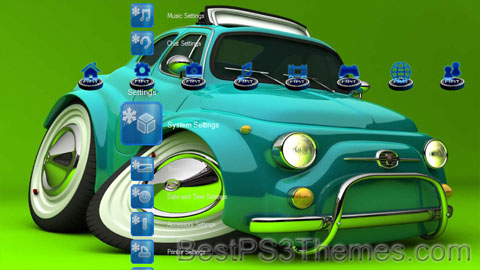
(1 background)
500 may refer to:
Saturn theme by Paja
Download: Saturn.p3t
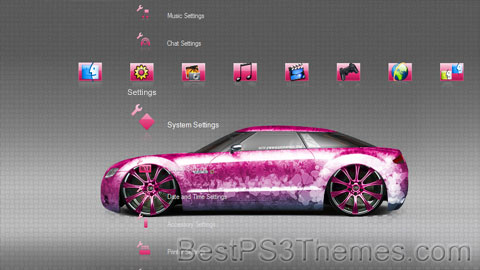
(1 background)
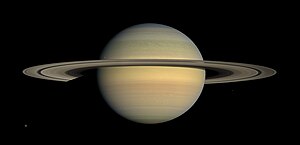 | |||||||||||||
| Designations | |||||||||||||
|---|---|---|---|---|---|---|---|---|---|---|---|---|---|
| Pronunciation | /ˈsætərn/ [1] | ||||||||||||
Named after | Saturn | ||||||||||||
| Adjectives | Saturnian /səˈtɜːrniən/,[2] Cronian[3] / Kronian[4] /ˈkroʊniən/[5] | ||||||||||||
| Symbol | |||||||||||||
| Orbital characteristics[6] | |||||||||||||
| Epoch J2000.0 | |||||||||||||
| Aphelion | 1,514.50 million km (10.1238 AU) | ||||||||||||
| Perihelion | 1,352.55 million km (9.0412 AU) | ||||||||||||
| 1,433.53 million km (9.5826 AU) | |||||||||||||
| Eccentricity | 0.0565 | ||||||||||||
| |||||||||||||
| 378.09 days | |||||||||||||
Average orbital speed | 9.68 km/s (6.01 mi/s) | ||||||||||||
| 317.020°[8] | |||||||||||||
| Inclination | |||||||||||||
| 113.665° | |||||||||||||
| 2032-Nov-29[10] | |||||||||||||
| 339.392°[8] | |||||||||||||
| Known satellites | 146 with formal designations; innumerable additional moonlets.[11][12] | ||||||||||||
| Physical characteristics[6] | |||||||||||||
Mean radius | 58,232 km (36,184 mi)[b]
9.1402 Earths | ||||||||||||
Equatorial radius |
| ||||||||||||
Polar radius |
| ||||||||||||
| Flattening | 0.09796 | ||||||||||||
| Circumference | 365882.4 km (227348.8 mi) (equatorial)[13] | ||||||||||||
| Volume |
| ||||||||||||
| Mass |
| ||||||||||||
Mean density | 0.687 g/cm3 (0.0248 lb/cu in)[c] 0.1246 Earths | ||||||||||||
| 0.22[15] | |||||||||||||
| 35.5 km/s (22.1 mi/s)[b] | |||||||||||||
| 10 h 32 m 36 s; 10.5433 hours,[16] 10 h 39 m; 10.7 hours[7] | |||||||||||||
| 10h 33m 38s + 1m 52s − 1m 19s [17][18] | |||||||||||||
Equatorial rotation velocity | 9.87 km/s (6.13 mi/s; 35,500 km/h)[b] | ||||||||||||
| 26.73° (to orbit) | |||||||||||||
North pole right ascension | 40.589°; 2h 42m 21s | ||||||||||||
North pole declination | 83.537° | ||||||||||||
| Albedo | |||||||||||||
| |||||||||||||
| −0.55[23] to +1.17[23] | |||||||||||||
| −9.7[24] | |||||||||||||
| 14.5″ to 20.1″ (excludes rings) | |||||||||||||
| Atmosphere[6] | |||||||||||||
Surface pressure | 140 kPa[25] | ||||||||||||
| 59.5 km (37.0 mi) | |||||||||||||
| Composition by volume | |||||||||||||
Saturn is the sixth planet from the Sun and the second-largest in the Solar System, after Jupiter. It is a gas giant with an average radius of about nine-and-a-half times that of Earth.[26][27] It has only one-eighth the average density of Earth, but is over 95 times more massive.[28][29][30] Even though Saturn is nearly the size of Jupiter, Saturn has less than one-third of Jupiter's mass. Saturn orbits the Sun at a distance of 9.59 AU (1,434 million km) with an orbital period of 29.45 years.
Saturn's interior is thought to be composed of a rocky core, surrounded by a deep layer of metallic hydrogen, an intermediate layer of liquid hydrogen and liquid helium, and finally, a gaseous outer layer. Saturn has a pale yellow hue due to ammonia crystals in its upper atmosphere. An electrical current within the metallic hydrogen layer is thought to give rise to Saturn's planetary magnetic field, which is weaker than Earth's, but which has a magnetic moment 580 times that of Earth due to Saturn's larger size. Saturn's magnetic field strength is around one-twentieth of Jupiter's.[31] The outer atmosphere is generally bland and lacking in contrast, although long-lived features can appear. Wind speeds on Saturn can reach 1,800 kilometres per hour (1,100 miles per hour).
The planet has a bright and extensive ring system composed mainly of ice particles, with a smaller amount of rocky debris and dust. At least 146 moons[32] are known to orbit the planet, of which 63 are officially named; this does not include the hundreds of moonlets in its rings. Titan, Saturn's largest moon and the second largest in the Solar System, is larger (while less massive) than the planet Mercury and is the only moon in the Solar System to have a substantial atmosphere.[33]
Saturn is named after the Roman god of wealth and agriculture and father of Jupiter. Its astronomical symbol (![]() ) has been traced back to the Greek Oxyrhynchus Papyri, where it can be seen to be a Greek kappa-rho ligature with a horizontal stroke, as an abbreviation for Κρονος (Cronus), the Greek name for the planet (
) has been traced back to the Greek Oxyrhynchus Papyri, where it can be seen to be a Greek kappa-rho ligature with a horizontal stroke, as an abbreviation for Κρονος (Cronus), the Greek name for the planet (![]() ).[34] It later came to look like a lower-case Greek eta, with the cross added at the top in the 16th century to Christianize this pagan symbol.
).[34] It later came to look like a lower-case Greek eta, with the cross added at the top in the 16th century to Christianize this pagan symbol.
The Romans named the seventh day of the week Saturday, Sāturni diēs ("Saturn's Day"), for the planet Saturn.[35]
Saturn is a gas giant composed predominantly of hydrogen and helium. It lacks a definite surface, though it is likely to have a solid core.[36] Saturn's rotation causes it to have the shape of an oblate spheroid; that is, it is flattened at the poles and bulges at its equator. Its equatorial radius is more than 10% larger than its polar radius: 60,268 km versus 54,364 km (37,449 mi versus 33,780 mi).[6] Jupiter, Uranus, and Neptune, the other giant planets in the Solar System, are also oblate but to a lesser extent. The combination of the bulge and rotation rate means that the effective surface gravity along the equator, 8.96 m/s2, is 74% of what it is at the poles and is lower than the surface gravity of Earth. However, the equatorial escape velocity of nearly 36 km/s is much higher than that of Earth.[37]
Saturn is the only planet of the Solar System that is less dense than water—about 30% less.[38] Although Saturn's core is considerably denser than water, the average specific density of the planet is 0.69 g/cm3 due to the atmosphere. Jupiter has 318 times Earth's mass,[39] and Saturn is 95 times Earth's mass.[6] Together, Jupiter and Saturn hold 92% of the total planetary mass in the Solar System.[40]

Despite consisting mostly of hydrogen and helium, most of Saturn's mass is not in the gas phase, because hydrogen becomes a non-ideal liquid when the density is above 0.01 g/cm3, which is reached at a radius containing 99.9% of Saturn's mass. The temperature, pressure, and density inside Saturn all rise steadily toward the core, which causes hydrogen to be a metal in the deeper layers.[40]
Standard planetary models suggest that the interior of Saturn is similar to that of Jupiter, having a small rocky core surrounded by hydrogen and helium, with trace amounts of various volatiles.[41] Analysis of the distortion shows that Saturn is substantially more centrally condensed than Jupiter and therefore contains a significantly larger amount of material denser than hydrogen near its centre. Saturn's central regions contain about 50% hydrogen by mass, while Jupiter's contain approximately 67% hydrogen.[42]
This core is similar in composition to Earth, but is more dense. The examination of Saturn's gravitational moment, in combination with physical models of the interior, has allowed constraints to be placed on the mass of Saturn's core. In 2004, scientists estimated that the core must be 9–22 times the mass of Earth,[43][44] which corresponds to a diameter of about 25,000 km (16,000 mi).[45] However, measurements of Saturn's rings suggest a much more diffuse core with a mass equal to about 17 Earths and a radius equal to around 60% of Saturn's entire radius.[46] This is surrounded by a thicker liquid metallic hydrogen layer, followed by a liquid layer of helium-saturated molecular hydrogen that gradually transitions to a gas with increasing altitude. The outermost layer spans about 1,000 km (620 mi) and consists of gas.[47][48][49]
Saturn has a hot interior, reaching 11,700 °C (21,100 °F) at its core, and radiates 2.5 times more energy into space than it receives from the Sun. Jupiter's thermal energy is generated by the Kelvin–Helmholtz mechanism of slow gravitational compression, but such a process alone may not be sufficient to explain heat production for Saturn, because it is less massive. An alternative or additional mechanism may be the generation of heat through the "raining out" of droplets of helium deep in Saturn's interior. As the droplets descend through the lower-density hydrogen, the process releases heat by friction and leaves Saturn's outer layers depleted of helium.[50][51] These descending droplets may have accumulated into a helium shell surrounding the core.[41] Rainfalls of diamonds have been suggested to occur within Saturn, as well as in Jupiter[52] and ice giants Uranus and Neptune.[53]
The outer atmosphere of Saturn contains 96.3% molecular hydrogen and 3.25% helium by volume.[54] The proportion of helium is significantly deficient compared to the abundance of this element in the Sun.[41] The quantity of elements heavier than helium (metallicity) is not known precisely, but the proportions are assumed to match the primordial abundances from the formation of the Solar System. The total mass of these heavier elements is estimated to be 19–31 times the mass of Earth, with a significant fraction located in Saturn's core region.[55]
Trace amounts of ammonia, acetylene, ethane, propane, phosphine, and methane have been detected in Saturn's atmosphere.[56][57][58] The upper clouds are composed of ammonia crystals, while the lower level clouds appear to consist of either ammonium hydrosulfide (NH4SH) or water.[59] Ultraviolet radiation from the Sun causes methane photolysis in the upper atmosphere, leading to a series of hydrocarbon chemical reactions with the resulting products being carried downward by eddies and diffusion. This photochemical cycle is modulated by Saturn's annual seasonal cycle.[58] Cassini observed a series of cloud features found in northern latitudes, nicknamed the "String of Pearls". These features are cloud clearings that reside in deeper cloud layers.[60]
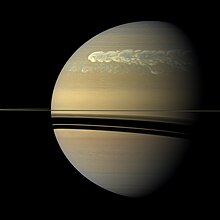
Saturn's atmosphere exhibits a banded pattern similar to Jupiter's, but Saturn's bands are much fainter and are much wider near the equator. The nomenclature used to describe these bands is the same as on Jupiter. Saturn's finer cloud patterns were not observed until the flybys of the Voyager spacecraft during the 1980s. Since then, Earth-based telescopy has improved to the point where regular observations can be made.[61]
The composition of the clouds varies with depth and increasing pressure. In the upper cloud layers, with temperatures in the range of 100–160 K and pressures extending between 0.5–2 bar, the clouds consist of ammonia ice. Water ice clouds begin at a level where the pressure is about 2.5 bar and extend down to 9.5 bar, where temperatures range from 185 to 270 K. Intermixed in this layer is a band of ammonium hydrosulfide ice, lying in the pressure range 3–6 bar with temperatures of 190–235 K. Finally, the lower layers, where pressures are between 10 and 20 bar and temperatures are 270–330 K, contains a region of water droplets with ammonia in aqueous solution.[62]
Saturn's usually bland atmosphere occasionally exhibits long-lived ovals and other features common on Jupiter. In 1990, the Hubble Space Telescope imaged an enormous white cloud near Saturn's equator that was not present during the Voyager encounters, and in 1994 another smaller storm was observed. The 1990 storm was an example of a Great White Spot, a short-lived phenomenon that occurs once every Saturnian year, roughly every 30 Earth years, around the time of the northern hemisphere's summer solstice.[63] Previous Great White Spots were observed in 1876, 1903, 1933, and 1960, with the 1933 storm being the best observed.[64] The latest giant storm was observed in 2010. In 2015, researchers used Very Large Array telescope to study Saturnian atmosphere, and reported that they found "long-lasting signatures of all mid-latitude giant storms, a mixture of equatorial storms up to hundreds of years old, and potentially an unreported older storm at 70°N".[65]
The winds on Saturn are the second fastest among the Solar System's planets, after Neptune's. Voyager data indicate peak easterly winds of 500 m/s (1,800 km/h).
Porsche theme by Paja
Download: Porsche_2.p3t
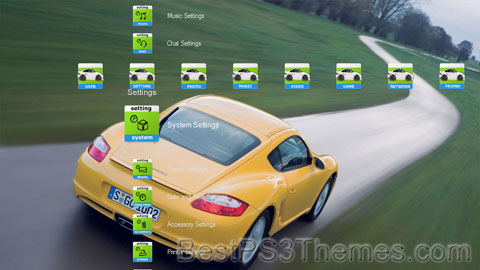
(3 backgrounds)
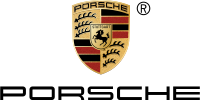 | |
 Headquarters in Stuttgart | |
| Company type | Public (AG) |
|---|---|
| FWB: P911 DAX component | |
| ISIN | DE000PAG9113 |
| Industry | Automotive |
| Founded | 1931 in Stuttgart, Germany |
| Founder | Ferdinand Porsche |
| Headquarters | Stuttgart, Germany |
Area served | Worldwide |
Key people | Wolfgang Porsche (chairman) Oliver Blume (CEO)[1] |
| Products | Automobiles |
Production output | |
| Services | Automotive financial services, engineering services, investment management |
| Revenue | |
| Total assets | |
| Total equity | |
| Owners |
|
Number of employees | 39,162 (2022)[2] |
| Subsidiaries |
|
| Website | www |
Dr. Ing. h.c. F. Porsche AG, usually shortened to Porsche (German pronunciation: [ˈpɔʁʃə] ; see below), is a German automobile manufacturer specializing in luxury, high-performance sports cars, SUVs and sedans, headquartered in Stuttgart, Baden-Württemberg, Germany. The company is owned by Volkswagen AG, a controlling stake of which is owned by Porsche Automobil Holding SE. Porsche's current lineup includes the 718, 911, Panamera, Macan, Cayenne and Taycan.
The origins of the company date to the 1930s when Czech-German automotive engineer Ferdinand Porsche founded Porsche[4] with Adolf Rosenberger, a keystone figure in the creation of German automotive manufacturer and Audi precursor Auto Union,[5] and Austrian businessman Anton Piëch, who was, at the time, also Ferdinand Porsche's son in law. In its early days, it was contracted by the German government to create a vehicle for the masses, which later became the Volkswagen Beetle.[6] After World War II, when Ferdinand would be arrested for war crimes, his son Ferry Porsche began building his own car, which would result in the Porsche 356.
In 2009, Porsche entered an agreement with Volkswagen to create an 'integrated working group' by merging the two companies' car manufacturing operations.[7][8] By 2015, Porsche SE, the holding company spun off from the original Porsche firm, had a controlling interest in the Volkswagen Group, which included Audi and Lamborghini as subsidiaries.[9]
Ferdinand Porsche (1875–1951) founded the company called "Dr. Ing. h. c. F. Porsche GmbH"[4] with Adolf Rosenberger[10] and Anton Piëch in 1931.[11] The name is short for Ferdinand Porsche's full title in German, Doktor Ingenieur honoris causa lit. 'Doctor of Engineering, Honorary Degree' Ferdinand Porsche.[12] The main offices was at Kronenstraße 24 in the centre of Stuttgart.[13] Initially, the company offered motor vehicle development work and consulting,[4] but did not build any cars under its own name. One of the first assignments the new company received was from the German government to design a car for the people; that is, a Volkswagen.[4] This resulted in the Volkswagen Beetle, one of the most successful car designs of all time.[6] Later, the Porsche 64 would be developed in 1939 using many components from the Beetle.[4]


During World War II,[14] Volkswagen production turned to the military version of the Volkswagen Beetle, the Kübelwagen,[14] 52,000 produced, and Schwimmwagen,[14] 15,584 produced.[15] Porsche produced several designs for heavy tanks during the war, losing out to Henschel & Son in both contracts that ultimately led to the Tiger I and the Tiger II. However, not all this work was wasted, as the chassis Porsche designed for the Tiger I was used as the base for the Elefant tank destroyer. Porsche also developed the Maus super-heavy tank in the closing stages of the war, producing two prototypes.[16] Ferdinand Porsche's biographer, Fabian Müller, wrote that Porsche had thousands of people forcibly brought to work at their factories during the war. The workers wore the letter "P" on their clothing at all times. It stood not for "Porsche", but for "Poland".[17]
At the end of World War II in 1945, the Volkswagen factory at KdF-Stadt fell to the British. Ferdinand lost his position as chairman of the board of management of Volkswagen, and Ivan Hirst, a British Army major, was put in charge of the factory. (In Wolfsburg, the Volkswagen company magazine dubbed him "The British Major who saved Volkswagen".)[18] On 15 December of that year, Ferdinand was arrested for war crimes, but not tried. During his 20-month imprisonment, Ferdinand Porsche's son, Ferry Porsche, decided to build his own car, because he could not find an existing one that he wanted to buy. He also had to steer the company through some of its most difficult days until his father's release in August 1947.[19]
The first models of what was to become the 356 were built in a small sawmill in Gmünd, Austria.[19] The prototype car was shown to German auto dealers, and when pre-orders reached a set threshold, production (with aluminum body) was begun by Porsche Konstruktionen GesmbH, founded by Ferry and Louise. Many regard the 356 as the first Porsche simply because it was the first model sold by the fledgling company. After production of the 356 was taken over by the father's Dr. Ing. h.c. F. Porsche GmbH in Stuttgart in 1950, Porsche commissioned a Zuffenhausen-based company, Reutter Karosserie, which had previously collaborated with the firm on Volkswagen Beetle prototypes, to produce the 356's steel body. In 1952, Porsche constructed an assembly plant (Werk 2) across the street from Reutter Karosserie; the main road in front of Werk 1, the oldest Porsche building, is now known as Porschestrasse.[20] The 356 was road-certified in 1948.
Porsche's company logo stems from the coat of arms of the Free People's State of Württemberg of Weimar Germany of 1918–1933, which had Stuttgart as its capital. (The Bundesland of Württemberg-Hohenzollern used the same arms from 1945 to 1952, while Stuttgart during these years operated as the capital of adjacent Württemberg-Baden.) The arms of Stuttgart appear in the middle of the logo as an inescutcheon, for the company had its headquarters in Stuttgart. The heraldic symbols, combined with the texts "Porsche" and "Stuttgart", do not form a conventional coat of arms, since heraldic achievements never spell out the name of the armiger nor the armiger's home town in the shield.
Württemberg-Baden and Württemberg-Hohenzollern both in 1952 became part of the present Bundesland of Baden-Württemberg after the political consolidation of West Germany in 1949, but the old design of the arms of Württemberg lives on in the Porsche logo. On 30 January 1951, not long before the formation of Baden-Württemberg, Ferdinand Porsche died from complications following a stroke.

In post-war Germany, parts were generally in short supply, so the 356 automobile used components from the Volkswagen Beetle, including the engine case from its internal combustion engine, transmission, and several parts used in the suspension. The 356, however, had several evolutionary stages, A, B, and C, while in production, and most Volkswagen-sourced parts were replaced by Porsche-made parts. Beginning in 1954 the 356s engines started utilizing engine cases designed specifically for the 356. The sleek bodywork was designed by Erwin Komenda, who also had designed the body of the Beetle. Porsche's signature designs have, from the beginning, featured air-cooled rear-engine configurations (like the Beetle), rare for other car manufacturers, but producing automobiles that are very well balanced.
In 1964, after a fair amount of success in motor-racing with various models including the 550 Spyder, and with the 356 needing a major re-design, the company launched the Porsche 911: another air-cooled, rear-engined sports car, this time with a six-cylinder "boxer" engine. The team to lay out the body shell design was led by Ferry Porsche's eldest son, Ferdinand Alexander Porsche (F. A.). The design phase for the 911 caused internal problems with Erwin Komenda, who led the body design department until then. F. A. Porsche complained Komenda made unauthorized changes to the design. Company leader Ferry Porsche took his son's drawings to neighbouring chassis manufacturer Reuter. Reuter's workshop was later acquired by Porsche (so-called Werk 2). Afterward, Reuter became a seat manufacturer, today known as Keiper-Recaro.

The design office gave sequential numbers to every project (See Porsche type numbers), but the designated 901 nomenclature contravened Peugeot's trademarks on all 'x0x' names, so it was adjusted to 911. Racing models adhered to the "correct" numbering sequence: 904, 906, 908. The 911 has become Porsche's most well-known model – successful on the race-track, in rallies, and in terms of road car sales. It remains in production; however, after several generations of revision, current-model 911s share only the basic mechanical configuration of a rear-engined, six-cylinder coupé, and basic styling cues with the original car. A cost-reduced model with the same body, but with a 356-derived four-cylinder engine, was sold as the 912.
In 1972, the company's legal form was changed from Kommanditgesellschaft (KG), or limited partnership, to Aktiengesellschaft (AG), or public limited company, because Ferry Porsche came to believe the scale of the company outgrew a "family operation", after learning about Soichiro Honda's "no family members in the company" policy at Honda. This led to the establishment of an executive board with members from outside the Porsche family, and a supervisory board consisting largely of family members. With this change, most family members in the operation of the company, including F. A. Porsche and Ferdinand Piëch, departed from the company.
F. A. Porsche founded his own design company, Porsche Design, which is renowned for exclusive sunglasses, watches, furniture, and many other luxury articles. Louise's son and Ferry's nephew Ferdinand Piëch, who was responsible for mechanical development of Porsche's production and racing cars (including the very successful 911, 908 and 917 models), formed his own engineering bureau, and developed a five-cylinder-inline diesel engine for Mercedes-Benz. A short time later he moved to Audi (used to be a division, then a subsidiary, of Volkswagen), and pursued his career through the entire company, ultimately becoming the chairman of Volkswagen Group.
The first chief executive officer (CEO) of Porsche AG was Ernst Fuhrmann, who had been working in the company's engine development division. Fuhrmann was responsible for the so-called Fuhrmann-engine, used in the 356 Carrera models as well as the 550 Spyder, having four overhead camshafts instead of a central camshaft with pushrods, as in the Volkswagen-derived serial engines. He planned to cease the 911 during the 1970s and replace it with the V8-front engined grand sportswagon 928. As we know today, the 911 outlived the 928 by far. Fuhrmann was replaced in the early 1980s by Peter W. Schutz, an American manager and self-proclaimed 911 aficionado. He was then replaced in 1988 by the former manager of German computer company Nixdorf Computer AG, Arno Bohn, who made some costly miscalculations that led to his dismissal soon after, along with that of the development director, Dr. Ulrich Bez, who was formerly responsible for BMW's Z1 model, and was CEO of Aston Martin from 2000 to 2013.[21]
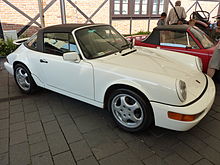
In 1990, Porsche drew up a memorandum of understanding with Toyota to learn and benefit from Japanese lean manufacturing methods. In 2004 it was reported that Toyota was assisting Porsche with hybrid technology.[22]
Following the dismissal of Bohn, Heinz Branitzki, a longtime Porsche employee, was appointed as interim CEO. Branitzki served in that position until Wendelin Wiedeking became CEO in 1993. Wiedeking took over the chairmanship of the board at a time when Porsche appeared vulnerable to a takeover by a larger company. During his long tenure, Wiedeking transformed Porsche into a very efficient and profitable company.
Ferdinand Porsche's nephew, Ferdinand Piëch, was chairman and CEO of the Volkswagen Group from 1993 to 2002 and is chairman of the Volkswagen AG Supervisory Board since then. With 12.8 percent of the Porsche SE voting shares, he also remains the second-largest individual shareholder of Porsche SE after his cousin, F. A. Porsche, which had 13.6 percent.
Porsche's 2002 introduction of the Cayenne also marked the unveiling of a new production facility in Leipzig, Saxony, which once accounted for nearly half of Porsche's annual output. In 2004, production of the 456 kilowatts (620 PS; 612 bhp) Carrera GT commenced in Leipzig, and at EUR 450,000 ($440,000 in the United States) it was the most expensive production model Porsche ever built.
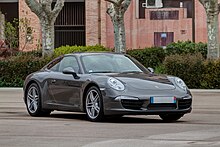
In mid-2006, after years of the Boxster (and later the Cayenne) as the best selling Porsche in North America, the 911 regained its position as Porsche's best-seller in the region. The Cayenne and 911 have cycled as the top-selling model since. In Germany, the 911 outsells the Boxster/Cayman and Cayenne.[23]
In May 2011, Porsche Cars North America announced plans to spend $80–$100 million, but will receive about $15 million in economic incentives to move their North American headquarters from Sandy Springs, a suburb of Atlanta, to Aerotropolis, Atlanta, a new mixed-use development on the site of the old Ford Hapeville plant adjacent to Atlanta's airport.[24] Designed by architectural firm HOK, the headquarters will include a new office building and test track.[25][26][27] The facility will be known by its new address, One Porsche Drive.
In October 2017, Porsche Cars North America announced the launch of Porsche Passport,[28] a new sports car and SUV subscription program. This new offering allows consumers to access Porsche vehicles through subscribing to the service, rather than owning or leasing a vehicle. The Porsche Passport service was available initially in Atlanta,[29][30] and has become available in many major cities across the US.[31]
During the COVID-19 pandemic, in March 2020, Porsche suspended its manufacturing in Europe for two weeks, "By taking this step, the sports car manufacturer is responding to the significant acceleration in the rate of infection caused by the coronavirus and the resultant measures implemented by the relevant authorities."[32]
In August 2022, Bloomberg News reported that Porsche has lined up interest in subscription of its initial public offering for a valuation between US$60–85 billion. It is expected to be listed on Frankfurt Stock Exchange in September.[33]

The company has always had a close relationship with, initially, the Volkswagen (VW) marque, and later, the Volkswagen Group (which also owns Audi AG), because the first Volkswagen Beetle was designed by Ferdinand Porsche.
The two companies collaborated in 1969 to make the VW-Porsche 914 and 914-6, whereby the 914-6 had a Porsche engine, and the 914 had a Volkswagen engine. Further collaboration in 1976 resulted in the Porsche 912E (US only) and the Porsche 924, which used many Audi components, and was built at Audi's Neckarsulm factory, which had been NSU's. Porsche 944s were also built there,[34] although they used far fewer Volkswagen components. The Cayenne, introduced in 2002, shares its chassis with the Volkswagen Touareg and the Audi Q7, which is built at the Volkswagen Group factory in Bratislava, Slovakia.


Jeep Grand Cherokee theme by Steve
Download: JeepGrandCherokee.p3t
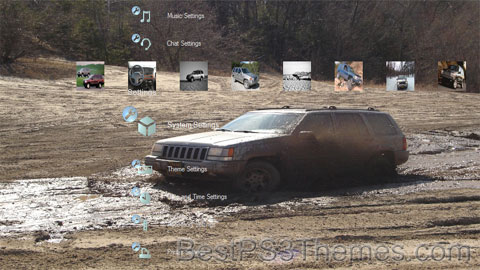
(1 background)
| Jeep Grand Cherokee | |
|---|---|
 | |
| Overview | |
| Manufacturer | Jeep[a] |
| Production | 1992–present |
| Model years | 1993–present |
| Body and chassis | |
| Class |
|
| Body style | 5-door SUV |
| Layout | |
| Chassis | Unibody |
The Jeep Grand Cherokee is a range of mid-size SUVs produced by the American manufacturer Jeep.[1] At its introduction, while most SUVs were still manufactured with body-on-frame construction, the Grand Cherokee has used a unibody chassis from the start.[2]
The Grand Cherokee's origins date back to 1983 when American Motors Corporation (AMC) was designing a successor to the Jeep Cherokee.[3] Three outside (non-AMC) designers—Larry Shinoda, Alain Clenet, and Giorgetto Giugiaro—were also under contract with AMC to create and build a clay model of the Cherokee XJ replacement, then known as the "XJC" project.[4] However, the basic design for the Cherokee's replacement was well under way by AMC's in-house designers and the 1989 Jeep Concept 1 show car foretold the basic design.[5]
As AMC began the development of the next Jeep in 1985, management created a business process that is now known as product lifecycle management (PLM).[6] According to François Castaing, Vice President for Product Engineering and Development, the smallest U.S. automaker was looking for a way to speed up its product development process to compete better against its larger competitors.[7] The XJC's development was aided by computer-aided design (CAD) software systems making the engineers more productive. Meanwhile, new communication systems allowed potential conflicts to be resolved faster, thus reducing costly engineering changes, because all drawings and documents were in a central database.[7] The system was so effective that after Chrysler purchased AMC in 1987, it expanded the system throughout its enterprise, thus connecting everyone involved in designing and building products.[7]
The Grand Cherokee thus became the first Chrysler-badged Jeep product. Development work for the new Jeep model continued and Chrysler's employees (after the 1987 buyout of AMC) were eager for a late-1980s release date; however, CEO Lee Iacocca was pushing for redesigned Chrysler minivans, thus delaying the Grand Cherokee's release until late 1992[8] as an Explorer competitor. Unlike the Explorer, the Grand Cherokee utilized monocoque (unibody) construction, whereas the Explorer was a derivative of the Ranger pickup with a separate body-on-frame. A Dodge-branded version was designed as a precaution should Jeep dealers struggle to handle so many Grand Cherokee units.[9]
The Grand Cherokee debuted in grand fashion at the 1992 North American International Auto Show in Detroit, Michigan. The vehicle that was driven was a Poppy Red Clear Coat 1993 Grand Cherokee ZJ Laredo with a quartz cloth interior and high-back bucket seats. Then Chrysler president Robert Lutz drove Detroit mayor, Coleman Young, from the Jefferson North Assembly Plant on North Jefferson Avenue via a police escort to Cobo Hall, up the steps of Cobo Hall and through a plate glass window to show off the new vehicle.[10] Sales of the 1993 model year Grand Cherokee began in April 1992.[11]
Production of the Grand Cherokee started shortly afterward in the purpose-built Jefferson North Assembly in Detroit, Michigan. European Grand Cherokees are manufactured in Austria by Magna Steyr.[12] The Grand Cherokee "played a significant part in reviving Chrysler's fortunes by moving it into the then-nascent market for high-margin sports utility vehicles."[13]
Upon its introduction, it was the first full-scale manufacture of an automobile in the US using HFC-134a refrigerant in place of HCFC-12 for the HVAC system.[14]


The original Grand Cherokee was launched in 1992 as a 1993 model year vehicle in the luxury SUV segment. The "ZJ" models, manufactured from 1992 until 1998, originally came in three trim levels: base (also known as SE), Laredo, and Limited, subsequent trims were added, including Orvis (MY 95–98) and TSI (MY97–98). The base model included features such as full instrumentation, a cloth interior, and a standard five-speed manual transmission, while gaining the moniker "SE" name for the 1994 model year. Power windows and locks were not standard equipment on the base trim. The minimal price tag differential resulted in low consumer demand, and as a result, the low-line model was eventually discontinued. Additional standard features included a driver-side airbag and a four-wheel anti-lock braking system (ABS). The Laredo was the mid-scale model with standard features that included power windows, power door locks, cruise control, and a leather-wrapped steering wheel. Exterior features included medium-grey plastic paneling on the lower body and five-spoke alloy wheels. The Limited was the premium model, featuring body-color lower body paneling, and gold exterior accents. The Limited also boasted standard features such as leather seating, heated mirrors, front power seats, a keyless entry system, woodgrain interior appliqué, lace style alloy wheels, a driver information center with a compass, digitized climate control, an electrochromic rearview mirror, and Jensen brand stereo with multi-band equalizer. By 1996 the options list grew to include heated seats. Standard was the 4.0 L engine, with the 5.2 L V8 (and 5.9 L in 1998) being optional, as with other models. Package groups with various trim levels included: fog lamps, and skid plates, as well as convenience, lighting, luxury, power, security, and trailer towing packages.
When it was first introduced in April 1992 as an early 1993 model year vehicle, the Grand Cherokee only had one powertrain choice: the 4.0 L AMC-derived straight-six engine that made 190 horsepower (193 PS; 142 kW). This became the "volume" engine for the Grand Cherokee. Transmission choices included a four-speed automatic transmission (early production ZJs used the AW4—the A500SE (later 42RE) replaced the AW4 during the latter half of the 1993 model year) or an Aisin AX15 manual transmission. Low demand for the manual transmission resulted in its discontinuation after 1994, but European-market ZJs retained it when coupled to the diesel engine (which was unavailable in North America). The drive train choices included rear-wheel drive or four-wheel-drive. In 1995, the engine's rating was reduced by 5 horsepower (5 PS; 4 kW) to 185 horsepower (188 PS; 138 kW) due to new EPA regulations starting with the 1996 model year.
In 1997, for the 1998 model year, a variant of the top-level Grand Cherokee Limited, the "5.9 Limited" was introduced. Jeep ads claimed it to be the "world's fastest sport utility vehicle", verified by third-party testing. The primary improvements in the 5.9 Limited version included a 245-horsepower (248 PS; 183 kW) 5.9 L OHV V8 engine, heavy-duty 46RE automatic transmission, functional heat-extracting hood louvers, unique wide-slot body-colored grille with mesh inserts, special rocker moldings, low-restriction exhaust with three-inch chrome tip, a low-profile roof rack, and special 16" Ultra-Star wheels. The 5.9 Limited also received a 150 amp alternator and a 2-speed electric cooling fan. Other features include a standard 180-watt, 10-speaker Infinity Gold sound system with a rear roof-mounted soundbar, standard sunroof, and an interior swaddled with unique "calf's nap" soft leather and faux wood trim. The 5.9 Limited was awarded "4×4 of the Year" for 1998 by Petersen's 4-Wheel & Off-Road magazine. The production of this model was 14,286 units.
Export models produced at the plant in Graz, Austria, were given the vehicle designation of "ZG".
| Years | Engine | Displacement | Power | Torque | Notes |
|---|---|---|---|---|---|
| 1992–1995 | 4.0 L Straight-6 | 242 CID | 190 hp (193 PS; 142 kW) | 225 lb⋅ft (305 N⋅m; 31 kg⋅m) | |
| 1995–1998 | 4.0 L Straight-6 | 242 CID | 185 hp (188 PS; 138 kW) | 220 lb⋅ft (298 N⋅m; 30 kg⋅m) | new emission standards introduced |
| 1992–1994 | 5.2 L V8 | 318 CID | 220 hp (223 PS; 164 kW) | 285 lb⋅ft (386 N⋅m; 39 kg⋅m) | |
| 1994–1998 | 5.2 L V8 | 318 CID | 220 hp (223 PS; 164 kW) | 300 lb⋅ft (407 N⋅m; 41 kg⋅m) | |
| 1995–1998 | 2.5 L TURBO DIESEL | VM Motori/Detroit Diesel | 115 hp (86 kW; 117 PS) | 221 lb⋅ft (300 N⋅m; 31 kg⋅m) | Not Available in North America |
| 1998 | 5.9 L V8 | 360 CID | 245 hp (248 PS; 183 kW) | 345 lb⋅ft (468 N⋅m; 48 kg⋅m) |
| Model[15] | 1993 | 1994 | 1995 | 1996 | 1997 | 1998 | Total |
|---|---|---|---|---|---|---|---|
| ZJ Grand Cherokee | 250,143 | 257,557 | 290,132 | 299,726 | 277,789 | 271,841 | 1,647,188 |
Launched in September 1998, the redesigned WJ 1999 Grand Cherokee shared just 127 parts with its predecessor (mostly fasteners). The European model was coded WG. The spare tire was relocated from the side of the cargo compartment to under the floor. (Like the 1998MY ZJ, the rear tailgate glass opened separately.) The two heavy pushrod V8 engines were replaced by Chrysler's then-new PowerTech. The new V8 engine produced less torque than the old pushrods, but was lighter, offered better fuel economy, and provided similar on-road performance figures (the 23-US-gallon (87 L; 19 imp gal) fuel tank was replaced with one of a 20.5-US-gallon (78 L; 17.1 imp gal) capacity). The straight-six engine was also updated. A redesign of the intake manifold added 10 horsepower (10 PS; 7 kW). While other Jeep vehicles used the Mopar 5 × 4.5 bolt circle, this was the first Jeep following the 1987 Chrysler buyout to receive a wider bolt pattern—5 × 5.
A notable feature available in this generation was the automatic four-wheel drive option called Quadra-Drive, which employed the New Venture Gear NV247 transfer case. This two-speed chain-driven transfer case uses a gerotor, a clutch pack coupled to a hydraulic pump, to transfer torque between the front and rear axles. The transfer case contains three modes, 4-All Time, Neutral, and 4-Lo. In 4-All Time, 100% of torque is sent to the rear axle in normal conditions. If the rear axle starts spinning at a higher rate than the front axle, hydraulic pressure builds up in the gerotor and causes the clutch pack to progressively transfer torque to the front axle until both axles return to the same speed. A neutral mode is intended for towing the vehicle. In 4-Lo, the front and rear axles are locked together through a 2.72 reduction gear ratio. The NV247 transfer case is mated to front and rear axles containing Jeep's Vari-Lok differentials. Vari-Lok differentials also use a gerotor to transfer torque between the wheels on either side of the axle. The major advantage of Quadra-Drive was that the combined transfer case and progressive locking differentials in each axle could automatically control traction between all four wheels. However, only the center differential could be permanently locked, and only in 4Lo. The Quadra-Trac II system included the NV247 transfer case with the standard open front and rear differentials.
The 45RFE and 545RFE automatic transmission in the WJ was notable. It included three planetary gear sets rather than the two normally used in a four-speed automatic. This gave it six theoretical speeds, and it would have been the first six-speed transmission ever produced in volume, but it was programmed to only use five of these ratios. Four were used for upshifts, with a different second gear for downshifts. Although five of the six ratios were used, Chrysler decided to call it a "4-speed automatic". For MY 2001, the programming was changed to make use of all six ratios. Rather than have six forward gears, the transmission was programmed to act as a five-speed with the alternate second gear for downshifts. The rpm at 70 miles per hour (110 km/h) on a 545RFE is 2,000 rpm, 200 rpm less than the 45RFE programming. 1999 and 2000 model-year WJ owners can have their 45RFE transmission's programming flashed to enable the extra gear as both transmissions are physically the same. (Must purchase new PCM and ABS module and program them with a fake VIN to make this work.) The 42RE 4-speed automatic remained the transmission for the inline 6 engine. It had slight changes from the previous model Grand Cherokee.
The interior was also completely redesigned. The redesign allowed for larger rear doors, and more space for rear passengers. Controls for various items like headlights, heated seats, and rear wiper were moved to more convenient locations. The electronic Vehicle Information center was moved from below the radio to above the windshield and was standard on 2000–2004 models. Limited models included automatic dual-zone climate control. A 10-CD changer was also available with the Infinity Audio package.
In addition to Jeep's UniFrame construction, Daimler Chrysler partnered with Porsche to further strengthen the frame.[citation needed] This was done to reduce Noise Vibration Harshness (NVH). UniFrame is an unusual construction scheme, it incorporates all of the strength and durability of a body-on-frame construction into a unitized construction. By adding stiffness and rigidity to the structure, they enhanced the ride and strengthened the network of steel beams, rails and pillars (or "safety cage") that surround and protect occupants. More than 70 percent of the underbody is high-strength steel. All Jeep Grand Cherokees feature UniFrame construction.
The Grand Cherokee received a minor facelift for 2004 including round fog lamps, a lower front fascia, and a new body color-matched inset grille design.
Export models produced at the plant in Graz, Austria, were given the vehicle designation of "WG".

| Model years | Engine | Displacement | Power | Torque | Notes |
|---|---|---|---|---|---|
| 1999–2002 | 3.1 L turbodiesel straight-5 | 3.1 liters (189 CID) | 140 hp (142 PS; 104 kW) | 271 lb⋅ft (367 N⋅m; 37 kg⋅m) | Not available in North America, manufactured by VM Motori |
| 1999–2004 (1999–2005 outside North America) | 4.0 L straight-6 | 4.0 liters (242 CID) | 195 hp (198 PS; 145 kW) | 230 lb⋅ft (312 N⋅m; 32 kg⋅m) | |
| 1999–2004 (1999–2005 outside North America) | 4.7 L V8 | 4.7 liters (287 CID) | 235 hp (238 PS; 175 kW) | 295 lb⋅ft (400 N⋅m; 41 kg⋅m) | |
| 2002–2005 | 2.7 L CRD diesel straight-5 | 2.7 liters (165 CID) | 163 hp (165 PS; 122 kW) | 295 lb⋅ft (400 N⋅m; 41 kg⋅m) | Not available in North America, manufactured by Mercedes-Benz |
| 2002–2004 (2002–2005 outside North America) | 4.7 L "High Output" V8 | 4.7 liters (287 CID) | 265 hp (269 PS; 198 kW) | 325 lb⋅ft (441 N⋅m; 45 kg⋅m) |


The WK Grand Cherokee debuted in 2004 for the 2005 model year at the 2004 New York International Auto Show with available Quadra-Drive II four-wheel drive, rear-seat DVD player and optional 5.7 L Hemi V8. The 3.7 L V6 engine replaced the 4.0 L straight-6. A Mercedes-Benz-sourced 3.0 L V6 Common Rail Diesel (CRD) was available outside of North America from launch.
Jeep replaced the XJ-era leading-arms live-axle front suspension (found in the ZJ and WJ) with an independent double-wishbone setup like that which debuted in the 2002 Liberty. Classed as a truck-based SUV, the WH/WK Grand Cherokee offers "crossover" refinement, capability, and NVH.
The 2007 Jeep Grand Cherokee made its European debut at the Euro Camp Jeep in Ardèche, France. This Jeep has gained 4 stars in the Euro NCAP crash safety tests conducted in 2005.
The Grand Cherokee received a minor facelift for 2008 with revised headlights and available High-Intensity Discharge (HID) Headlamps with auto-leveling. The lower portion of the front bumper was still removable as it was from launch to increase the approach angle for off-road use. The 4.7 L was refined, now producing 305 hp (227 kW; 309 PS), and 334 lb⋅ft (453 N⋅m; 46 kg⋅m).
The 2009 Jeep Grand Cherokee is available with an improved 5.7 L Hemi engine rated at 357 hp (362 PS; 266 kW) and 389 lb⋅ft (527 N⋅m; 53.8 kg⋅m) of torque. The engine uses variable valve timing to increase fuel economy.[16]
| Years | Engine | Displacement | Power | Torque | Notes |
|---|---|---|---|---|---|
| 2005–2010 | 3.7 L V6 | 225 CID (3,687 cc) | 215 hp (218 PS; 160 kW) | 235 lb⋅ft (319 N⋅m; 32 kg⋅m) | Base, Laredo, Laredo X, Limited |
| 2005–2007 | 4.7 L V8 | 287 CID (4,698 cc) | 230 hp (233 PS; 172 kW) | 295 lb⋅ft (400 N⋅m; 41 kg⋅m) | Laredo, Laredo X, Limited |
| 2008–2009 | 4.7 L V8 | 287 CID (4,698 cc) | 305 hp (309 PS; 227 kW) | 334 lb⋅ft (453 N⋅m; 46 kg⋅m) | Laredo, Laredo X, Limited |
| 2005–2008 | 5.7 L Hemi V8 | 345 CID (5,654 cc) | 325 hp (330 PS; 242 kW) | 369 lb⋅ft (500 N⋅m; 51 kg⋅m) | Laredo X, Limited, Overland |
| 2009–2010 | 5.7 L Hemi V8 | 345 CID (5,654 cc) | 357 hp (362 PS; 266 kW) | 389 lb⋅ft (527 N⋅m; 54 kg⋅m) | Laredo X, Limited, Overland |
| 2006–2010 | 6.1 L Hemi V8 | 370 CID (6,059 cc) | 420 hp (426 PS; 313 kW) | 420 lb⋅ft (569 N⋅m; 58 kg⋅m) | SRT8 |
| 2005–2010 Europe/ 2007–2009 North America | 3.0 L Mercedes-Benz OM642 V6 | 182 CID (2,988 cc) | 215 hp (218 PS; 160 kW) | 376 lb⋅ft (510 N⋅m; 52.0 kg⋅m) | CRD, Predator, Model S, Laredo X, Limited, Overland |
The fourth-generation WK2 Grand Cherokee went on sale in summer 2010 as a 2011 model.[17] It was unveiled at the 2009 New York Auto Show.[18] In 2009, during its development, Chrysler management used it as an example of future products to convince United States, federal regulators of Chrysler's future viability, for the purpose of requesting a federal loan. This culminated in the Chrysler Chapter 11 reorganization that same year.
Like previous generations, the WK2 Grand Cherokee chassis is a steel unibody. Unlike previous generations, it features four-wheel independent suspension for better on-road handling. The WK2 and 2011 Durango use a Chrysler-designed and engineered platform/chassis that Mercedes-Benz later used for the Mercedes-Benz W166 series. The Chrysler-designed platform was part of the DaimlerChrysler engineering projects that were to launch the WK2 Grand Cherokee with the Mercedes-Benz ML to follow.
Engine choices include the all-new 3.6 L Pentastar V6 and 5.7 L Hemi V8. The Hemi V8 retains the Multiple Displacement System (MDS) that shuts down four cylinders in low-power driving situations. The V8 included a multi-speed automatic transmission featuring Electronic Range Selection (ERS) to manually limit the high gear operating range. Trailer towing is rated 7,400 pounds (3,357 kg) for Hemi models and 6,800 pounds (3,084 kg) for Pentastar models.[19] A 3.0 L turbocharged diesel V6 developed and built by Fiat Powertrain Technologies and VM Motori (with Multijet II injection[20]) rated at 177 kW (241 PS; 237 hp) and 550 N⋅m (406 lb⋅ft; 56 kg⋅m) of torque offered in export markets from mid-2011.[21] The new 3.0 L CRD turbodiesel engine is available in European markets as 140 kW (190 PS; 188 hp) low-power version.[22]
The new Grand Cherokee SRT8, which started production on July 16, 2011,[23] is equipped with a 470-horsepower (350 kW; 477 PS) 6.4 L Hemi V8 engine. Jeep claims the new SRT8 gets 13 percent better fuel economy than its predecessor.[citation needed]
For the 2022 model year, Jeep marketed the outgoing Grand Cherokee WK2 alongside the all-new Grand Cherokee WL model as the Grand Cherokee WK (not to be confused with the Grand Cherokee (WK), which was produced from 2005 until 2010). The lineup is condensed to base Laredo "E", mid-level Laredo "X", and range-topping Limited trims, with the only engine option being the base 3.6 L Pentastar V6 gasoline engine.[24]
| Years | Engine | Displacement | Power | Torque | Notes |
|---|---|---|---|---|---|
| 2011–2022 | 3.6 L Pentastar V6 | 220 CID (3,604 cc) | 295 hp (299 PS; 220 kW) | 260 lb⋅ft (353 N⋅m; 36 kg⋅m) | Laredo, Laredo E, Laredo X, Altitude, Limited, Sterling Edition, Trailhawk, Overland, High Altitude, Summit[25] |
| 2011–2021 | 5.7 L Hemi V8 | 345 CID (5,654 cc) | 360 hp (365 PS; 268 kW) | 390 lb⋅ft (529 N⋅m; 54 kg⋅m) | Laredo X (up to 2013), Altitude (up to 2013), Limited, Sterling Edition, Trailhawk, Overland, High Altitude, Summit[25] |
| 2012–2021 | 6.4 L Hemi V8 | 392 CID (6,417 cc) | 470 hp (477 PS; 350 kW) | 470 lb⋅ft (637 N⋅m; 65 kg⋅m) | SRT8, SRT[26] |
| 2018–2021 | 6.2 L supercharged Hemi V8 | 376 CID (6,166 cc) | 707 hp (717 PS; 527 kW) | 645 lb⋅ft (875 N⋅m; 89 kg⋅m) | Trackhawk[27] |
| 2011–2018 | 3.0 L CRD V6 | 182 CID (2,988 cc) | 140 kW (190 PS; 188 hp) | 440 N⋅m (325 lb⋅ft; 45 kg⋅m) | US-spec lower output to meet emission standards |
| 2014–2020 | 3.0 L CRD V6 | 182 CID (2,988 cc) | 179 kW (243 PS; 240 hp) | 569 N⋅m (420 lb⋅ft; 58 kg⋅m) | Available outside North America from launch. US-spec Limited, Overland, Summit[25] |
| Fifth generation | |||||||||||||||||||||||||||||||||||||||||||||||||||
|---|---|---|---|---|---|---|---|---|---|---|---|---|---|---|---|---|---|---|---|---|---|---|---|---|---|---|---|---|---|---|---|---|---|---|---|---|---|---|---|---|---|---|---|---|---|---|---|---|---|---|---|
 2022 Jeep Grand Cherokee (WL) | |||||||||||||||||||||||||||||||||||||||||||||||||||
| Overview | |||||||||||||||||||||||||||||||||||||||||||||||||||
| Model code |
| ||||||||||||||||||||||||||||||||||||||||||||||||||
| Production | 2021–present | ||||||||||||||||||||||||||||||||||||||||||||||||||
| Model years | 2021–present (Grand Cherokee L) 2022–present (Grand Cherokee)[29] | ||||||||||||||||||||||||||||||||||||||||||||||||||
| Assembly |
ViperViper theme by S4LBULLET Download: Viper.p3t
The Viperidae (vipers) are a family of snakes found in most parts of the world, except for Antarctica, Australia,[2] Hawaii, Madagascar, New Zealand, Ireland, and various other isolated islands. They are venomous and have long (relative to non-vipers), hinged fangs that permit deep penetration and injection of their venom.[3] Three subfamilies are currently recognized.[4] They are also known as viperids. The name "viper" is derived from the Latin word vipera, -ae, also meaning viper, possibly from vivus ("living") and parere ("to beget"), referring to the trait viviparity (giving live birth) common in vipers like most of the species of Boidae.[5] Description[edit] All viperids have a pair of relatively long solenoglyphous (hollow) fangs that are used to inject venom from glands located towards the rear of the upper jaws, just behind the eyes. Each of the two fangs is at the front of the mouth on a short maxillary bone that can rotate back and forth. When not in use, the fangs fold back against the roof of the mouth and are enclosed in a membranous sheath. This rotating mechanism allows for very long fangs to be contained in a relatively small mouth. The left and right fangs can be rotated together or independently. During a strike, the mouth can open nearly 180° and the maxilla rotates forward, erecting the fangs as late as possible so that the fangs do not become damaged, as they are brittle. The jaws close upon impact and the muscular sheaths encapsulating the venom glands contract, injecting the venom as the fangs penetrate the target. This action is very fast; in defensive strikes, it will be more a stab than a bite. Viperids use this mechanism primarily for immobilization and digestion of prey. Pre-digestion occurs as the venom contains proteases, which degrade tissues. Secondarily, it is used for self defense, though in cases with nonprey, such as humans, they may give a dry bite (not inject any venom). A dry bite allows the snake to conserve its precious reserve of venom, because once it has been depleted, time is needed to replenish it, leaving the snake vulnerable. In addition to being able to deliver dry bites, vipers can inject larger quantities of venom into larger prey targets, and smaller amounts into small prey. This causes the ideal amount of predigestion for the lowest amount of venom. Almost all vipers have keeled scales, a stocky build with a short tail, and a triangle-shaped head distinct from the neck, owing to the location of the venom glands. The great majority have vertically elliptical, or slit-shaped, pupils that can open wide to cover most of the eye or close almost completely, which helps them to see in a wide range of light levels. Typically, vipers are nocturnal and ambush their prey.  Compared to many other snakes, vipers often appear rather sluggish. Most are ovoviviparous: the eggs are retained inside the mother's body, and the young emerge living. However, a few lay eggs in nests. Typically, the number of young in a clutch remains constant, but as the weight of the mother increases, larger eggs are produced, yielding larger young. Geographic range[edit] Viperid snakes are found in the Americas, Africa, Eurasia, and South Asia. In the Americas, they are native from south of 48°N. In the Old World, viperids are located everywhere except Siberia, Ireland, and north of the Arctic Circle in Norway and Sweden.[1] Wild viperids are not found in Australia. The common adder, a viperid, is the only venomous snake found in Great Britain. Venom[edit]Viperid venoms typically contain an abundance of protein-degrading enzymes, called proteases, that produce symptoms such as pain, strong local swelling and necrosis, blood loss from cardiovascular damage complicated by coagulopathy, and disruption of the blood-clotting system. Also being vasculotoxic in nature, viperine venom causes vascular endothelial damage and hemolysis. Death is usually caused by collapse in blood pressure. This is in contrast to elapid venoms, which generally contain neurotoxins that disable muscle contraction and cause paralysis. Death from elapid bites usually results from asphyxiation because the diaphragm can no longer contract, but this rule does not always apply; some elapid bites include proteolytic symptoms typical of viperid bites, while some viperid bites produce neurotoxic symptoms.[3] Proteolytic venom is also dual-purpose: first, it is used for defense and to immobilize prey, as with neurotoxic venoms; second, many of the venom's enzymes have a digestive function, breaking down molecules such as lipids, nucleic acids, and proteins.[6] This is an important adaptation, as many vipers have inefficient digestive systems.[7] Due to the nature of proteolytic venom, a viperid bite is often a very painful experience and should always be taken seriously, though it may not necessarily prove fatal. Even with prompt and proper treatment, a bite can still result in a permanent scar, and in the worst cases, the affected limb may even have to be amputated. A victim's fate is impossible to predict, as this depends on many factors, including the species and size of the snake involved, how much venom was injected (if any), and the size and condition of the patient before being bitten. Viper bite victims may also be allergic to the venom or the antivenom. Behavior[edit]These snakes can decide how much venom to inject depending on the circumstances. The most important determinant of venom expenditure is generally the size of the snake; larger specimens can deliver much more venom. The species is also important, since some are likely to inject more venom than others, may have more venom available, strike more accurately, or deliver a number of bites in a short time. In predatory bites, factors that influence the amount of venom injected include the size of the prey, the species of prey, and whether the prey item is held or released. The need to label prey for chemosensory relocation after a bite and release may also play a role. In defensive bites, the amount of venom injected may be determined by the size or species of the predator (or antagonist), as well as the assessed level of threat, although larger assailants and higher threat levels may not necessarily lead to larger amounts of venom being injected.[8] Prey tracking[edit] Hemotoxic venom takes more time than neurotoxic venom to immobilize prey, so viperid snakes need to track down prey animals after they have been bitten,[8] in a process known as "prey relocalization". Vipers are able to do this via certain proteins contained in their venom. This important adaptation allowed rattlesnakes to evolve the strike-and-release bite mechanism, which provided a huge benefit to snakes by minimizing contact with potentially dangerous prey animals.[9] This adaptation, then, requires the snake to track down the bitten animal to eat it, in an environment full of other animals of the same species. Western diamondback rattlesnakes respond more actively to mouse carcasses that have been injected with crude rattlesnake venom. When the various components of the venom were separated out, the snakes responded to mice injected with two kinds of disintegrins, which are responsible for allowing the snakes to track down their prey.[9] Subfamilies[edit]
Type genus = Vipera Laurenti, 1768[1] Sensory organs[edit]Heat-sensing pits[edit]Pit vipers have specialized sensory organs near the nostrils called heat-sensing pits.[10] The location of this organ is unique to pit vipers. These pits have the ability to detect thermal radiation emitted by warm-blooded animals, helping them better understand their environment.[11] Internally the organ forms a small pit lined with membranes, external and internal, attached to the trigeminal nerve.[10][12] Infrared light signals the internal membranes, which in turn signal the trigeminal nerve and send the infrared signals to the brain, where they are overlaid onto the visual image created by the eyes.[13] Taxonomy[edit]Whether family Viperidae is attributed to Oppel (1811), as opposed to Laurenti (1768) or Gray (1825), is subject to some interpretation. The consensus among leading experts, though, is that Laurenti used viperae as the plural of vipera (Latin for "viper", "adder", or "snake") and did not intend for it to indicate a family group taxon. Rather, it is attributed to Oppel, based on his Viperini as a distinct family group name, despite the fact that Gray was the first to use the form Viperinae.[1] See also[edit]
References[edit]
Further reading[edit]
External links[edit]Wikimedia Commons has media related to Viperidae.
| ||||||||||||||||||||||||||||||||||||||||||||||||||